Top 12 Applicant Tracking Systems in 2026

Applicant Tracking Systems (ATS) are essential tools for modern hiring. By 2026, ATS platforms are leveraging AI for resume screening, candidate matching, and predictive hiring outcomes. With over 98% of Fortune 500 companies using ATS, these systems help reduce time-to-hire by up to 30% and streamline recruitment processes with automation, analytics, and integrations.
Here’s a quick overview of the 12 top ATS platforms for 2026:
- Workable: AI-powered tools for job distribution, global hiring, and SMS-based communication.
- BambooHR: Combines ATS with HR management and onboarding features.
- Greenhouse: Focused on structured hiring and reducing bias.
- Lever: Blends ATS with CRM features for relationship-based recruiting.
- JazzHR: Budget-friendly option for small businesses with essential ATS features.
- Recruitee: Emphasizes team collaboration and customizable workflows.
- SmartRecruiters: Enterprise-level ATS with AI-driven candidate matching and global compliance tools.
- Ashby: Advanced analytics and flexible hiring pipelines for data-driven teams.
- Teamtailor: Combines ATS with employer branding tools and AI-driven recruitment.
- Breezy HR: Visual pipeline management and automated candidate sourcing.
- Manatal: Affordable, AI-powered ATS for small to medium-sized businesses.
- Rippling ATS: Integrated ATS with payroll, HR, and benefits management.
Key Trends in ATS for 2026:
- AI-powered screening for faster and smarter candidate evaluation.
- Video interview integration for seamless remote hiring.
- Predictive analytics to improve hiring success rates.
- Mobile-first designs for candidate convenience.
- Global compliance tools for international hiring.
Choosing the right ATS depends on your company size, hiring volume, and specific needs. For startups, JazzHR offers affordability, while enterprises might prefer Greenhouse or SmartRecruiters for advanced features. Always test platforms through free trials or demos to ensure they align with your goals.
Let AI do the work: Smarter ways to attract top talent
What to Look For in an ATS in 2026
Selecting the right applicant tracking system (ATS) in 2026 means focusing on features that meet the demands of modern recruiting. The best systems combine advanced automation with easy-to-use interfaces, helping hiring teams work faster and smarter. Here’s a breakdown of the key features that define top ATS platforms in 2026.
AI-Powered Resume Parsing and Screening is a must-have. These systems use AI to pull details from resumes and match candidates to job requirements. Many platforms now include generative AI tools for crafting job descriptions and reaching out to candidates. Some even feature AI-driven assistants that handle tasks like scheduling interviews, answering basic questions, and maintaining communication through chatbots.
Intelligent Sourcing and Talent Analytics set leading platforms apart. AI-powered sourcing tools help recruiters find passive candidates and predict future hiring needs, ensuring talent pipelines are ready before a job even opens.
Seamless Integration Capabilities are critical for keeping workflows smooth. Look for systems that connect easily with HRIS, payroll software, and video interview tools like Zoom, Microsoft Teams, or Google Meet. Browser extensions for sourcing and messaging integrations can also save recruiters time and effort.
On top of integration, strong Analytics and Reporting features are essential for making data-driven decisions. The best systems track key metrics like cost per hire, time to hire, pipeline efficiency, and application sources. Customizable dashboards and detailed reports make it easier for leadership to see the return on investment in recruiting efforts.
A Mobile-First Candidate Experience is non-negotiable in 2026. Candidates expect a smooth process on their phones, from applying to receiving updates. Look for ATS platforms that support personalized feedback, 24/7 chatbot assistance, and branded career pages optimized for mobile devices.
Diversity and Inclusion Tools are increasingly important, both for meeting compliance standards and achieving organizational goals. Modern systems offer features to reduce bias, anonymize resumes, and monitor diversity metrics at every stage of recruitment.
Lastly, Ethical AI and Compliance Features are crucial for navigating regulations. With global and local laws evolving, it’s vital to choose systems that provide transparency in how AI makes decisions, allow for human oversight, and include tools for auditing bias in hiring processes.
Keeping these features in mind will help you evaluate and choose the ATS that best meets your organization's needs.
1. Workable

Workable stands out as a modern applicant tracking system packed with AI-powered features designed to simplify hiring and HR management.
Website: workable.com
Workable is more than just an ATS - it’s a fully integrated HR solution. It combines applicant tracking, HRIS, time tracking, and advanced AI tools to optimize every step of the hiring process. Recognized by Forbes Advisor as the "Best AI-Powered Recruiting Platform for 2024"[3], Workable addresses the challenges of modern recruitment with cutting-edge tools and a user-friendly approach. Let’s break down what makes it a leader among applicant tracking systems in 2026.
Key Features
Extensive Job Board Distribution
Workable automatically shares job postings across 200+ free and premium job boards[2][3][4], giving companies access to a broad and diverse talent pool.
Massive Passive Candidate Database
Recruiters can tap into a database of over 400 million candidate profiles[2][3][4]. This feature is especially helpful for sourcing passive candidates who aren’t actively searching for jobs but match the company’s needs.
AI-Enhanced Communication Tools
With AI-driven tools, Workable achieves an impressive 98% response rate using SMS communication, which is 60 times faster than traditional email[3]. AI also assists with job descriptions, interview preparation, and candidate screening, making the entire process more efficient.
Global Hiring Capabilities
Workable supports hiring in six languages and includes automated translation features[2]. It also ensures compliance with major international regulations and holds strong security certifications, which are crucial for global recruitment efforts in 2026.
Comprehensive Integration Network
The platform connects seamlessly with 70+ recruiting and HR tools[2]. This reduces manual data entry and ensures smoother workflows by fitting into existing tech ecosystems.
Pros and Cons
| Pros | Cons |
|---|---|
| Combines ATS, HRIS, and time tracking in one platform | May offer more features than needed for smaller hiring operations |
| Access to over 400 million candidate profiles | Advanced features might require some technical setup |
| AI-powered tools for efficient recruitment | Could feel overwhelming for small teams looking for simpler solutions |
| High response rates with SMS communication | |
| Broad job board reach for diverse candidate sourcing |
Best For
Workable is an excellent choice for mid-size to large companies managing high-volume hiring across multiple locations and languages. Businesses seeking AI-driven tools and strong integration options will find its features particularly appealing.
With over 30,000 companies in 100+ countries relying on Workable - and 95% of reviewers recommending it[3][4] - this platform continues to deliver intelligent, scalable recruiting solutions for today’s global workforce.
2. BambooHR

BambooHR brings together applicant tracking and comprehensive HR management, making it a go-to platform for growing businesses.
Website: bamboohr.com
BambooHR stands out as an HR solution that integrates recruiting with broader HR management. Unlike platforms that focus solely on applicant tracking, BambooHR offers an all-in-one system that streamlines everything from sourcing candidates to onboarding new hires. This makes it an excellent choice for businesses aiming to simplify their HR operations under a single platform.
Key Features
Smart Candidate Sourcing
BambooHR simplifies job postings by automatically distributing them across multiple job boards. Its algorithms rank candidates based on criteria you set, helping you focus on the best matches.
Integrated Onboarding
Once a hire is made, BambooHR transitions candidates seamlessly into its employee management system. New hires can complete paperwork online and access key company policies, saving time and reducing manual tasks.
Mobile-Friendly Recruiting
With the BambooHR mobile app, hiring managers can review resumes, schedule interviews, and communicate with candidates from anywhere. This feature is especially helpful for remote teams or managers who are frequently on the move.
Customizable Hiring Processes
Tailor workflows to fit your company's unique needs. From interview setups to approval chains, BambooHR adapts to your existing procedures, so you don’t have to overhaul your current processes.
Detailed Reporting Tools
The platform’s analytics dashboard tracks essential metrics like time-to-hire, cost-per-hire, and the effectiveness of different sourcing channels. These insights help HR teams pinpoint inefficiencies and improve their recruiting strategies.
Pros and Cons
| Pros | Cons |
|---|---|
| Combines recruiting with full HR management | Higher cost compared to standalone ATS platforms |
| Smooth onboarding process for new hires | Some advanced features require additional purchases |
| Strong mobile app for hiring on the go | Can feel complex for teams used to simpler tools |
| Excellent customer support and training | Limited integration options with niche recruiting tools |
| User-friendly interface with minimal learning curve |
Pricing
BambooHR offers custom pricing based on the size of your company and the features you need. For detailed pricing information, you’ll need to reach out to BambooHR directly.
Best For
BambooHR is ideal for small to medium-sized businesses looking for a unified HR solution that covers both recruiting and employee management. It’s particularly useful for companies experiencing growth, as it eliminates the need for juggling multiple software platforms.
Additionally, businesses in regulated industries will appreciate BambooHR’s compliance tools, which help maintain proper documentation and audit trails throughout the hiring and employment process. Its intuitive design also makes it a great fit for HR teams that want powerful tools without needing extensive technical expertise.
3. Greenhouse

Greenhouse is a high-end applicant tracking system (ATS) designed for teams that prioritize structured hiring and data-driven decisions.
Website: greenhouse.io
Greenhouse stands out for its focus on minimizing hiring bias and improving candidate quality through structured processes and AI-powered evaluations. It’s a great choice for companies looking to professionalize their hiring approach, making decisions based on data rather than intuition. Let’s dive into its standout features and what they bring to the table.
Key Features
Structured Interview Kits
Greenhouse offers ready-to-use interview templates that promote consistent and fair candidate evaluations. These kits include scorecards, allowing interviewers to assess candidates based on the same criteria, which helps reduce bias and improve overall hiring outcomes.
Advanced Analytics Dashboard
The platform provides in-depth metrics covering sourcing channels, interviewer performance, and diversity tracking. You can identify which job boards yield the best candidates, pinpoint bottlenecks in your hiring process, and measure the time spent at each stage of recruitment.
Collaborative Hiring Tools
Greenhouse enables team-based evaluations with shared scorecards and feedback forms. Feedback from multiple team members is consolidated, ensuring informed and balanced hiring decisions.
Candidate Experience Portal
Candidates gain access to a personalized portal where they can track their application progress, schedule interviews, and upload documents. This self-service feature not only engages candidates but also reduces administrative tasks for HR teams.
Integration Ecosystem
Greenhouse integrates with over 300 third-party tools, including background check services, skills assessments, and video interview platforms. This flexibility allows companies to build a recruiting tech stack tailored to their specific needs.
Pros and Cons
| Pros | Cons |
|---|---|
| Excellent tools for structured interviewing | Premium pricing may be too high for smaller businesses |
| Detailed analytics and reporting capabilities | Steeper learning curve for beginners |
| Focus on reducing hiring bias | Some features require technical setup |
| Wide range of third-party integrations | Can feel overly complex for simpler hiring needs |
| Strong candidate experience features | Limited customization in lower-tier plans |
Pricing
Greenhouse pricing is customized based on company needs. Basic plans start around $6,000 annually, while enterprise-level packages can exceed $25,000 per year. For exact pricing, you’ll need to contact Greenhouse directly.
Best For
Greenhouse is ideal for mid-size to large companies that handle high-volume recruiting and value structured, systematic hiring processes. It’s especially well-suited for technology firms, consulting agencies, and organizations where hiring quality is a top priority.
This platform is particularly beneficial for teams that emphasize structured interviews and have the resources to fully utilize its advanced features. Companies committed to diversity and inclusion efforts will appreciate Greenhouse’s tools for reducing bias and its detailed diversity reporting. Additionally, organizations with complex approval workflows or multiple stakeholders involved in hiring decisions will find its collaborative features and customizable workflows highly effective.
4. Lever

Lever is a modern applicant tracking system (ATS) that blends traditional ATS functions with CRM-style features, focusing on building long-term relationships with candidates - a game-changer for companies hiring in specialized or competitive markets.
Website: lever.co
What sets Lever apart is its approach to recruiting as a relationship-building journey rather than a simple transactional process. Its tools are designed to help businesses maintain strong talent pipelines, making it a go-to solution for roles that require niche expertise or are in high demand.
Key Features
Nurture Campaigns
Lever's automated nurture sequences keep passive candidates engaged over time. Through personalized emails, it shares company updates, relevant content, and job opportunities, ensuring your talent pool stays active and interested - whether you're hiring now or in the future.
Unified Candidate Database
The platform provides a comprehensive view of every candidate by tracking all interactions, interview feedback, and communication history. This 360-degree candidate profile makes it easy to re-engage promising talent when new opportunities arise.
Pipeline Management
With Lever's visual pipeline interface, recruiters can simply drag and drop candidates through different stages of the hiring process. Detailed notes and feedback are easy to maintain, and the system automatically monitors key metrics like time-to-hire, helping identify bottlenecks in your workflow.
Collaborative Feedback System
Lever simplifies team collaboration with customizable scorecards and structured feedback tools. It consolidates input from interview panels into clear summaries, so hiring managers can make faster, better-informed decisions.
Advanced Search and Sourcing
Lever’s search tools go beyond basic keyword matching. Recruiters can find candidates by skills, experience, past interactions, and even custom tags. The system also integrates with platforms like LinkedIn, letting you directly import candidate profiles for seamless sourcing.
This emphasis on relationship-building and personalized engagement reflects the evolving needs of the ATS market, where automation and meaningful connections are key.
Pros and Cons
| Pros | Cons |
|---|---|
| Great for maintaining long-term candidate relationships | Steeper learning curve for teams new to CRM-style recruiting |
| Strong tools for pipeline management and nurturing | Limited customization options for smaller teams |
| User-friendly drag-and-drop interface | Reporting features could be stronger compared to enterprise-level competitors |
| Excellent collaboration features for hiring teams | Integration setup may be tricky for less technical users |
| Mobile app is responsive and functional | Pricing might be high for startups with smaller hiring needs |
Pricing
Lever offers three pricing tiers to suit different needs. The Starter plan begins at $599 per month for up to 25 employees. The Pro plan, designed for medium-sized teams, costs $899 per month for up to 100 employees. For larger organizations, Enterprise pricing is available on request, typically ranging between $1,500 and $3,000 per month, depending on company size and feature requirements.
Best For
Lever is ideal for growing businesses and scale-ups focused on building strong talent pipelines in competitive industries. It’s particularly well-suited for technology companies, creative agencies, and consulting firms.
The platform excels for organizations hiring for specialized roles that often require longer recruitment cycles - think senior engineering positions, executive roles, or niche technical skills. Companies that prioritize candidate engagement and relationship management will find Lever’s nurturing tools invaluable for keeping passive candidates connected and ready for future opportunities.
Recruiting agencies and talent acquisition teams managing multiple hiring managers or clients will also benefit from Lever’s collaborative tools and detailed candidate tracking capabilities.
5. JazzHR

JazzHR is designed with small to mid-sized businesses in mind, offering essential applicant tracking system (ATS) features at a budget-friendly price. It's a great choice for companies looking for professional recruiting tools without the added complexity of enterprise-level software.
Website: jazzhr.com
Instead of packing in unnecessary features, JazzHR focuses on what matters most: job postings, candidate tracking, team collaboration, and basic reporting. This streamlined approach keeps things simple and effective.
Key Features
Multi-Channel Job Posting
JazzHR ensures your job openings reach a wide audience by automatically posting to over 20 job boards, helping you attract more candidates.
Candidate Tracking & Team Collaboration
With its user-friendly interface, JazzHR simplifies candidate tracking and makes it easy for teams to stay updated and work together seamlessly.
Metrics Tracking That Matters
JazzHR provides tools to monitor key recruiting metrics like time-to-hire and source effectiveness - perfect for businesses working with tight budgets.
By balancing ease of use with essential functionality, JazzHR is a strong option for companies that value cost-efficiency and simplicity.
Pros and Cons
| Pros | Cons |
|---|---|
| Budget-friendly for small businesses | Lacks advanced features found in higher-end ATS platforms |
| Easy-to-use interface with minimal training required | Reporting tools may not meet the needs of data-heavy operations |
| Excellent integration with leading job boards |
Pricing
JazzHR offers flexible pricing tailored to your company’s size and needs. Its packages are generally more affordable compared to enterprise-level solutions, making it accessible for smaller businesses.
Best For
JazzHR is ideal for small to mid-sized businesses, especially startups, local companies, and regional organizations that want professional hiring tools without the steep costs or complexity of larger systems. Industry experts have recognized JazzHR for its strengths in areas like analytics, implementation services, time-to-hire tracking, and user experience [5]. It’s a reliable choice for streamlining the recruitment process while staying within budget.
6. Recruitee
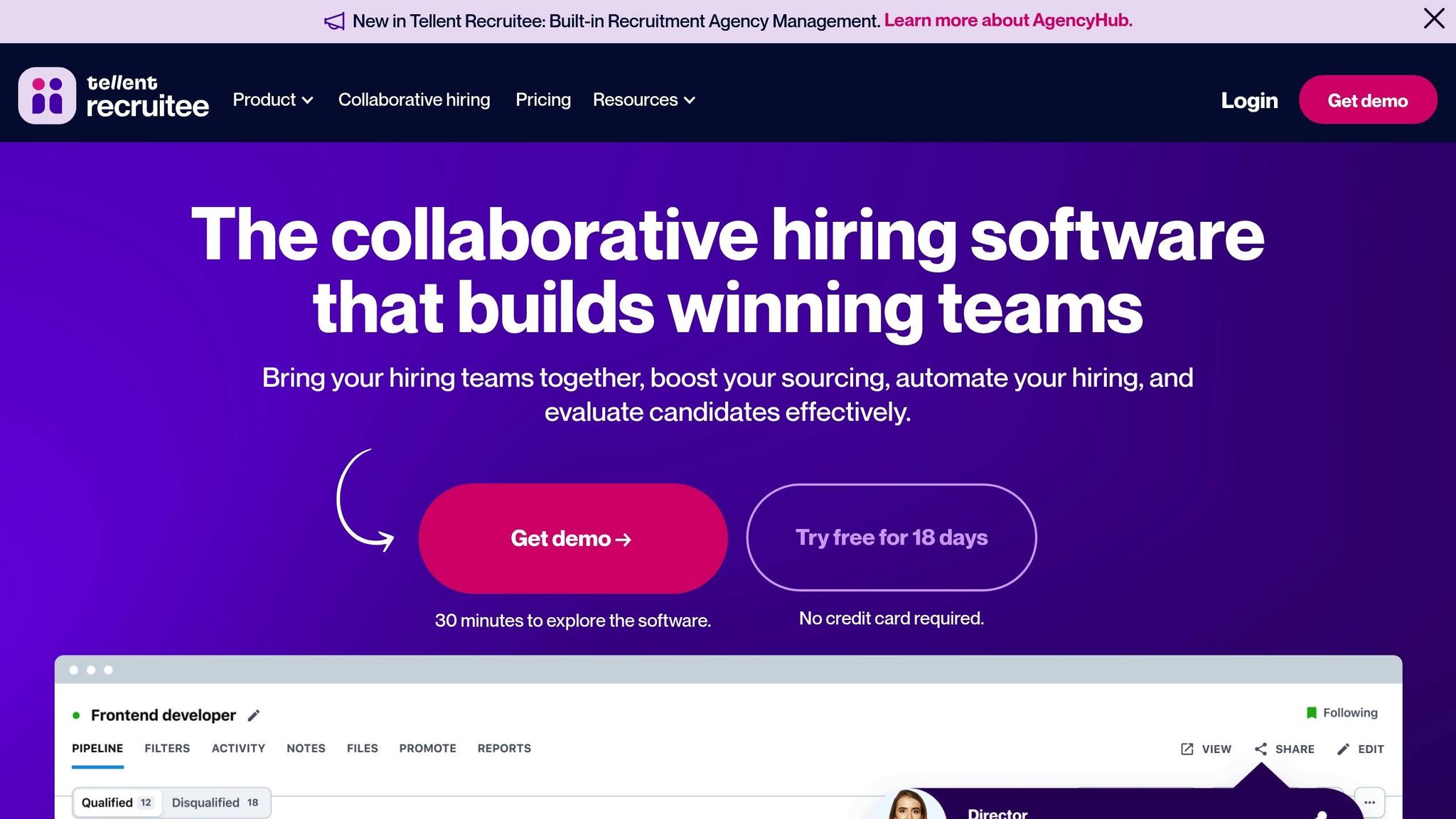
Recruitee focuses on making recruitment a team effort, offering a sleek and user-friendly platform designed to bring hiring teams together. It emphasizes collaboration throughout the hiring process, ensuring that everyone involved can contribute to evaluating candidates and making decisions seamlessly.
Website: recruitee.com
Key Features
Team Collaboration Tools
Recruitee creates a shared workspace where hiring managers, HR professionals, and team members can collaborate in real-time. Users can share feedback, rate candidates, and collectively decide on hires. The platform also features customizable hiring pipelines with drag-and-drop functionality, allowing teams to build workflows that suit their specific needs.
Candidate Sourcing Made Easy
With built-in tools for sourcing passive candidates, Recruitee goes beyond standard job boards. Integration with social media and talent pool management helps expand your reach and attract a broader range of applicants.
Mobile-First Accessibility
Recruitee’s responsive mobile interface ensures hiring teams can review applications, provide feedback, and make decisions anytime, anywhere - perfect for remote or on-the-go recruitment.
Analytics Dashboard
The platform provides detailed metrics to help you track and improve your hiring process. Insights include time-to-hire, source effectiveness, and team productivity, giving you a clear picture of your recruitment performance.
These features highlight Recruitee’s focus on collaborative, data-driven hiring.
Pros and Cons
| Pros | Cons |
|---|---|
| Excellent real-time collaboration features for hiring teams | May feel excessive for smaller teams with simpler hiring needs |
| Customizable workflows and pipelines for tailored processes | Pricing can be a hurdle for startups with tight budgets |
| Advanced sourcing tools to find candidates beyond job boards | Teams moving from basic systems may face a learning curve |
| Mobile-friendly design supports remote hiring | Some advanced tools may require additional training to master |
Pricing
Recruitee uses a per-user, per-month pricing model, starting at approximately $199 per month for smaller teams. Pricing scales based on team size and feature requirements, with custom options available for larger organizations with more complex recruitment needs.
Best For
Recruitee is a great fit for growing companies and scale-ups that need more than basic hiring tools. It’s particularly suited for organizations with 5-50 employees, such as tech startups, creative agencies, and consulting firms, where multiple team members are involved in hiring decisions. Companies operating in remote or hybrid work environments will also benefit from Recruitee’s mobile-friendly design and real-time collaboration features, which align with modern recruitment practices.
7. SmartRecruiters

SmartRecruiters is an all-in-one applicant tracking system designed for enterprise-level hiring. It manages the entire recruitment process, from job postings to onboarding, ensuring a cohesive and efficient experience. With advanced analytics and AI tools, SmartRecruiters simplifies high-volume hiring while maintaining a robust feature set for recruiters.
Website: smartrecruiters.com
Key Features
Talent Acquisition Suite
SmartRecruiters provides a full recruitment ecosystem. It supports job distribution across over 200 job boards, candidate relationship management, and interview scheduling. Its AI-driven matching technology scores and ranks candidates based on job criteria, allowing recruiters to focus on top talent.
Advanced Analytics and Reporting
Beyond standard ATS capabilities, SmartRecruiters delivers advanced analytics with customizable dashboards. Recruiters can track metrics like cost-per-hire, time-to-fill, and source effectiveness. Additionally, predictive analytics help anticipate hiring needs and identify potential challenges in the recruitment process.
Marketplace Integration
The platform supports a marketplace model, enabling seamless integration with specialized tools like background check providers, assessment platforms, and video interviewing software. This flexibility allows companies to create a recruitment tech stack tailored to their needs.
Global Compliance Management
For businesses hiring across borders, SmartRecruiters provides features to handle regional regulations, GDPR compliance, and equal opportunity reporting, ensuring smooth international recruitment processes.
Pros and Cons
| Pros | Cons |
|---|---|
| Enterprise-level features for comprehensive recruitment | Higher costs may deter smaller businesses |
| Effective AI-powered candidate matching | Setup can be time-intensive |
| Broad third-party integrations through its marketplace | Interface might feel overwhelming for basic needs |
| Strong global compliance and reporting tools | Customer support response times can be slower |
Pricing
SmartRecruiters follows a custom pricing model, starting at around $10,000 annually. For larger enterprises, costs can range from $25,000 to over $100,000, depending on the number of users and advanced features required. Pricing details are not listed publicly, so interested businesses need to request a quote from the sales team.
Best For
SmartRecruiters is ideal for mid-to-large enterprises with 100+ employees that require advanced recruitment tools. It's especially useful for companies handling high-volume hiring, such as retail chains, healthcare providers, and rapidly growing tech firms. Businesses with global operations will appreciate its compliance features, while those with dedicated talent acquisition teams can make the most of its analytics and marketplace integrations to enhance their hiring strategies.
sbb-itb-88a7fe6
8. Ashby
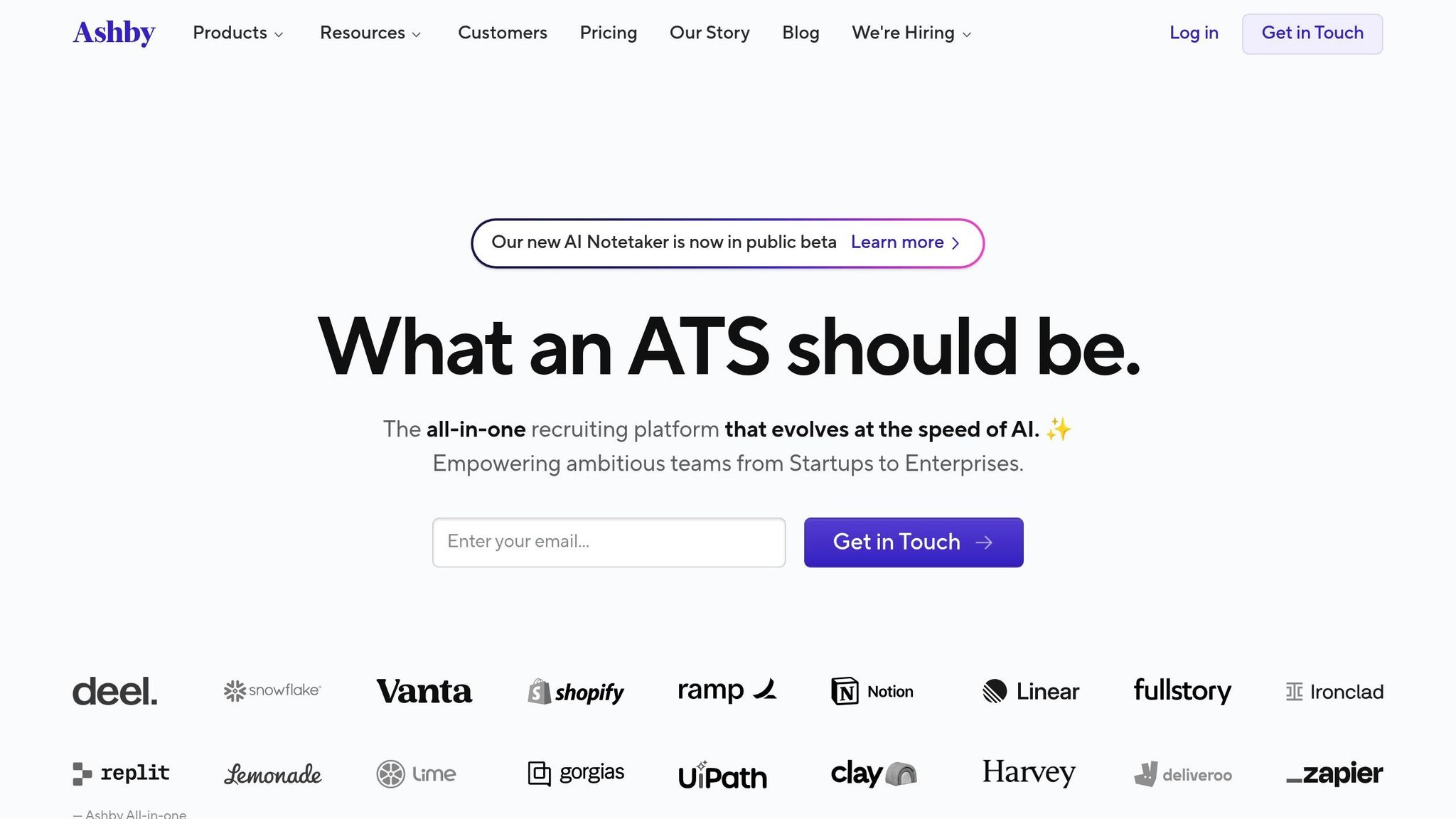
Ashby is crafted for recruiting teams that prioritize advanced analytics and personalized workflows. Unlike traditional applicant tracking systems (ATS), Ashby zeroes in on delivering detailed insights into hiring performance while keeping the user experience straightforward. Its standout capability lies in helping recruiters gain a deeper understanding of their processes through advanced data analysis. Here's a look at what makes Ashby different from other ATS platforms.
Website: ashbyhq.com
Key Features
Advanced Analytics Dashboard
Ashby’s analytics engine is a game-changer, offering detailed monitoring at every hiring stage. Recruiters can track conversion rates between interview rounds, evaluate the effectiveness of candidate sources, and pinpoint bottlenecks in their workflow. With real-time reporting and customizable visuals like charts and graphs, teams can make informed, data-driven decisions to refine their strategies.
Flexible Pipeline Management
The platform allows for highly customizable workflows, adaptable to various roles and departments. From setting up unique interview stages to automating repetitive tasks and defining approval processes, Ashby ensures the hiring pipeline aligns with your team’s specific needs. Features like candidate scoring and tailored evaluation criteria provide even more precision.
Seamless Calendar Integration
Ashby integrates effortlessly with Google Calendar and Outlook, syncing schedules to avoid conflicts. Its intelligent scheduling tool simplifies coordinating complex interview panels, even across multiple time zones. This feature is especially useful for companies with remote or global teams.
Collaborative Hiring Tools
Collaboration is at the heart of Ashby’s design. Shared candidate notes, structured feedback forms, and streamlined decision-making workflows make it easy for hiring managers and teams to work together. The platform ensures all stakeholders can contribute to and stay aligned on hiring decisions.
Together, these features create a tailored and efficient recruiting experience for teams.
Pros and Cons
| Pros | Cons |
|---|---|
| Advanced analytics and detailed reporting | Limited job board integrations compared to competitors |
| Highly customizable workflows | Steeper learning curve for non-technical users |
| User-friendly interface with strong design | Fewer third-party app integrations |
| Excellent collaboration tools for teams | Custom pricing may be cost-prohibitive for smaller teams |
Pricing
Ashby operates on a custom pricing model, with costs starting at approximately $8,000 annually for smaller teams. For mid-sized companies, pricing typically ranges from $15,000 to $40,000 per year, while larger enterprises may pay upwards of $60,000 annually. Pricing depends on factors like the number of active recruiters, hiring volume, and specific feature requirements. To get an exact quote, companies need to contact Ashby’s sales team directly.
Best For
Ashby is ideal for tech companies and startups with 50-500 employees that prioritize data-driven recruiting. It’s especially well-suited for organizations handling high-volume technical hiring or those with remote or distributed teams needing advanced scheduling tools. Fast-growing businesses will appreciate its customizable workflows, which can adapt to evolving recruitment needs. Ashby is a strong choice for teams that value analytics and process optimization over extensive third-party integrations, making it a go-to platform for modern hiring challenges in 2026.
9. Teamtailor
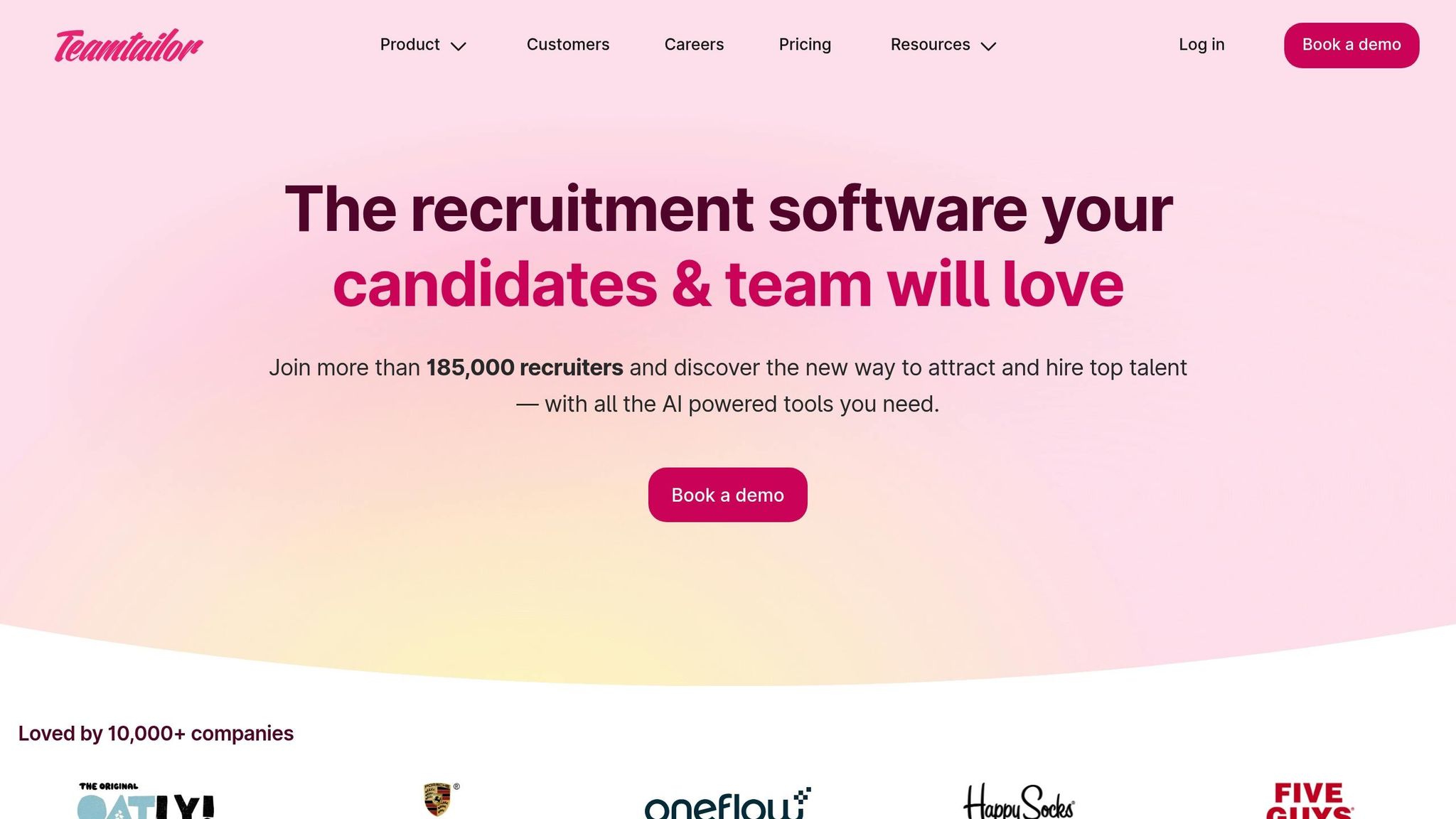
Teamtailor combines applicant tracking system (ATS) functionality with tools for employer branding, making it a go-to choice for over 10,000 organizations and 150,000 recruiters worldwide [6][7]. This platform is designed to simplify hiring while creating an engaging experience for candidates.
Website: teamtailor.com
Here’s a closer look at what makes Teamtailor stand out:
Key Features
AI-Powered Recruitment Tools
Teamtailor uses artificial intelligence to enhance the hiring process. Features like resume summarization, automated job description creation, and smart candidate screening help recruiters quickly identify top talent. By comparing resumes against job requirements and generating concise summaries, it saves time on initial screenings without compromising quality.
Customizable Career Pages and Employer Branding
The platform allows businesses to highlight their company culture through personalized, mobile-friendly career pages. These pages integrate with social media, enabling companies to broaden their reach while showcasing their values and work environment.
Collaborative Hiring Tools
Teamtailor makes teamwork easy during the hiring process. Multiple team members can review candidates, share feedback, and make decisions using structured guides and scorecards. This approach promotes better collaboration and ensures a more thorough evaluation of candidates.
Focus on Skills-Based Assessments
With tools for skills-based interviewing and assessments, Teamtailor lets recruiters create custom evaluation criteria and conduct structured interviews. This method aligns with modern hiring practices, which prioritize demonstrated skills over traditional qualifications.
Pros and Cons
| Pros | Cons |
|---|---|
| Customizable career pages that enhance employer branding; Advanced AI tools for efficient candidate screening; Strong collaboration features for team-based hiring; Supports skills-focused assessments | No major drawbacks have been widely reported [6] |
Pricing
For detailed pricing information, visit teamtailor.com.
Best For
Teamtailor is ideal for companies of all sizes, from small businesses to large enterprises, that want to improve candidate quality, cultural alignment, and retention. It’s particularly suited for organizations looking to integrate AI into their hiring processes, whether for resume summarization, job description creation, or candidate screening. With 97% of users reporting an increase in qualified candidates [6] and 94% noting improved team collaboration [6], Teamtailor is a great choice for businesses aiming to enhance their employer branding and adopt modern recruitment technology.
10. Breezy HR
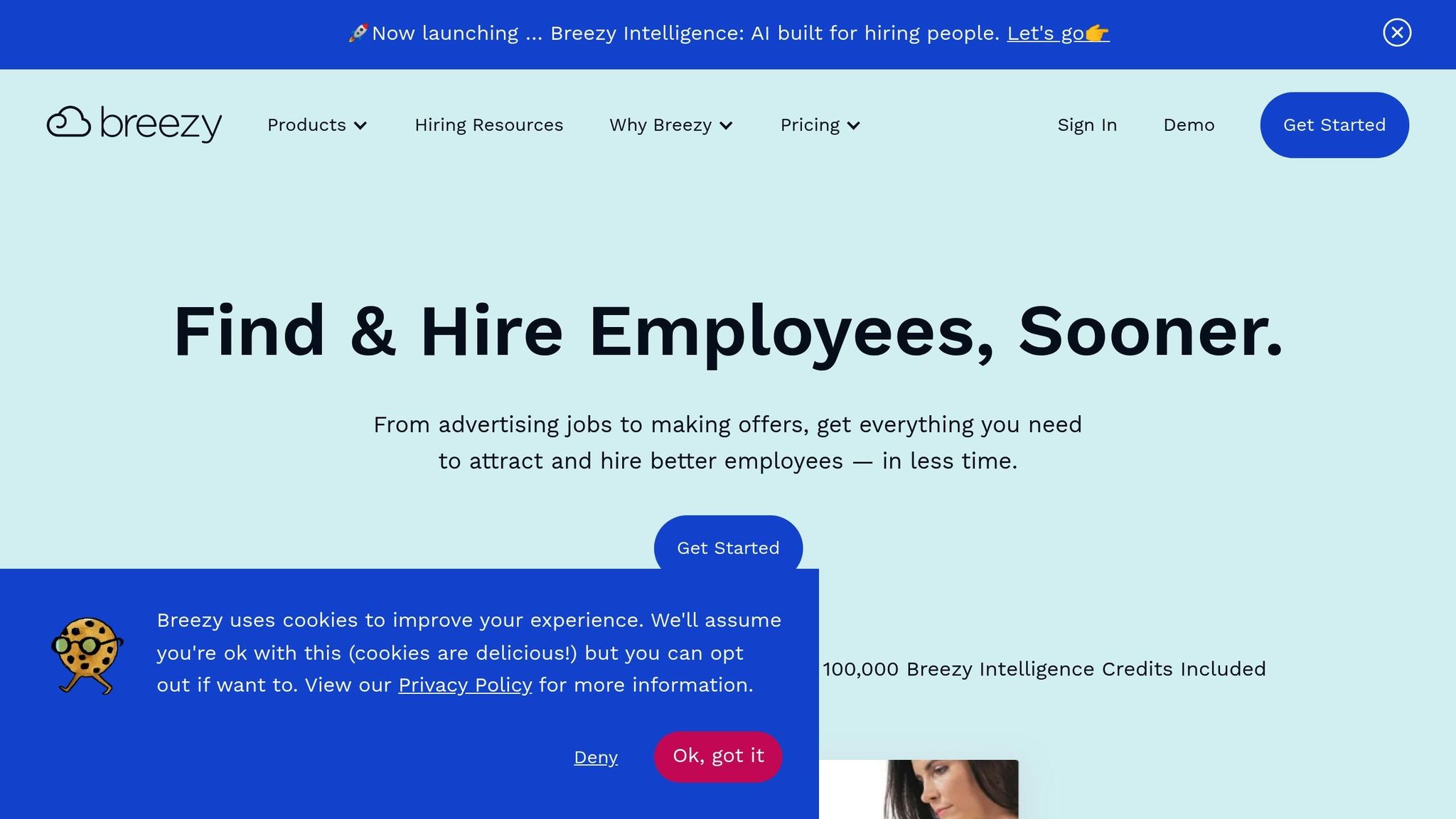
Breezy HR is an easy-to-use applicant tracking system (ATS) designed to simplify the recruitment process. With its intuitive interface and a variety of features, it’s a solid choice for modern hiring teams.
Website: breezy.hr
Key Features
Visual Pipeline Management
Breezy HR offers a drag-and-drop, kanban-style interface that makes it simple to track candidates through each stage of the hiring process. This visual layout helps recruiters quickly identify bottlenecks and stay organized.
Automated Candidate Sourcing
The platform automatically posts job openings to over 50 major job boards, saving time and ensuring broad visibility with minimal effort.
Customizable Hiring Workflows
Whether your team needs a basic two-step interview process or a detailed multi-stage evaluation, Breezy HR allows you to design hiring workflows that fit your specific needs.
Team Collaboration Tools
Breezy HR enhances team collaboration with shared feedback tools and integrated scheduling that syncs with popular calendar apps, making interview coordination seamless.
Candidate Experience Features
To keep candidates engaged, Breezy HR provides automated status updates, personalized communication templates, and a mobile-friendly application process.
Pros and Cons
Here’s a quick look at the strengths and limitations of Breezy HR:
| Pros | Cons |
|---|---|
| Easy-to-learn drag-and-drop interface; Saves time with extensive job board integration; Flexible workflows to match various hiring needs; Strong collaboration tools for team-based hiring decisions | Limited advanced reporting compared to larger enterprise platforms; Customization may feel overwhelming for new users |
Pricing
Breezy HR offers flexible pricing plans with both monthly and annual options:
- Bootstrap: Free forever plan for one active position or candidate pool [8]
- Startup: $157/month when billed annually (includes two months free with annual billing) [8]
For larger organizations, a Custom Pro Plan is available, offering advanced features and dedicated support. Plus, Breezy HR provides a 14-day free trial that doesn’t require a credit card. Users can easily switch plans as their hiring needs evolve.
Best For
Breezy HR is ideal for small to medium-sized businesses looking for a tool that balances simplicity with functionality. Its visual workflow management and job board integration make it especially appealing for teams that don’t need the complexity of enterprise-level systems. Startups or smaller teams will appreciate the free Bootstrap plan, while growing organizations can scale with the paid options.
11. Manatal
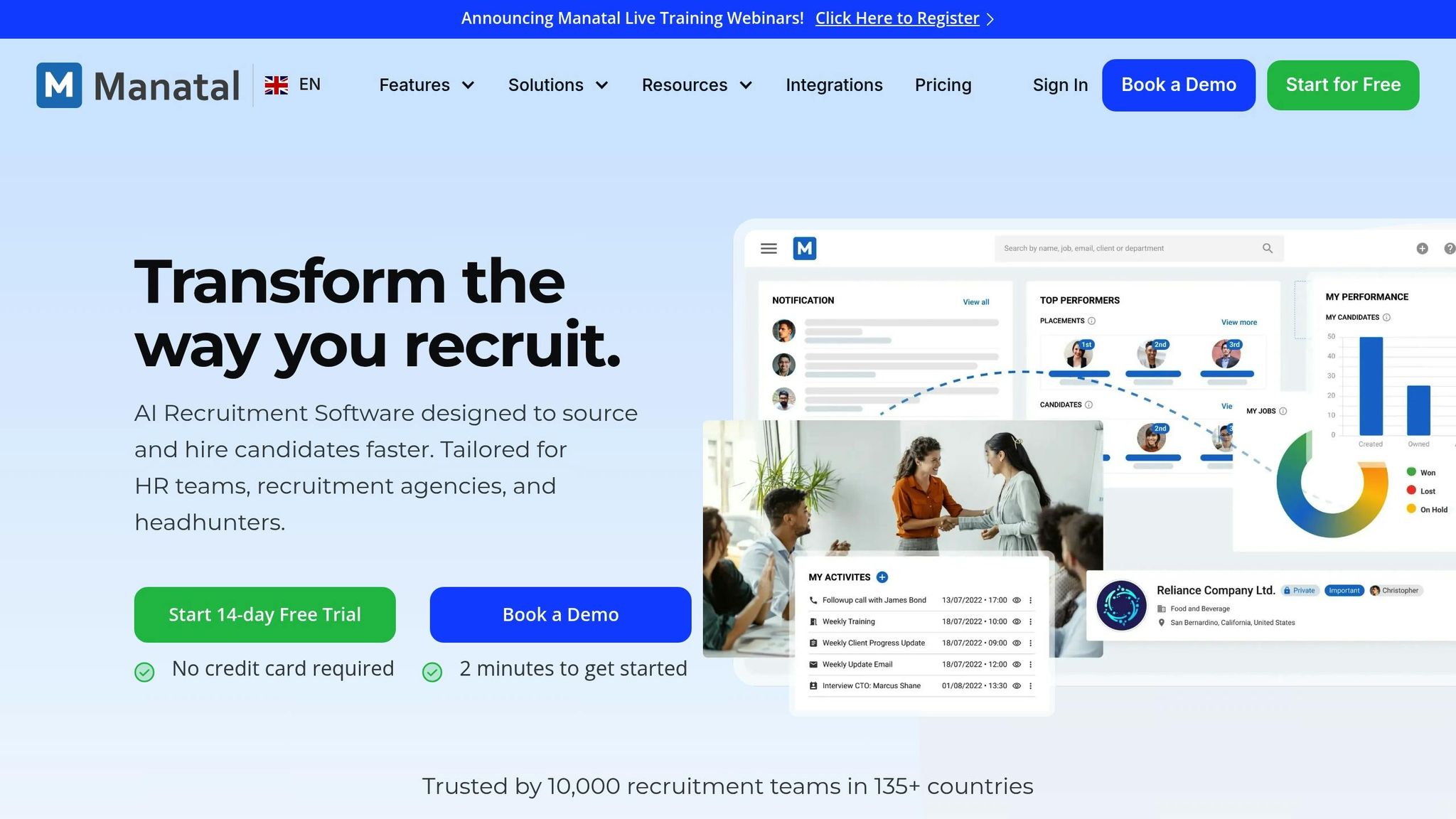
Manatal stands out as an applicant tracking system (ATS) thanks to its straightforward design and pricing structure. With its transparent costs and adaptable plans, it’s a practical choice for small to medium-sized businesses aiming to streamline their hiring processes.
Website: manatal.com
Key Features
- Four pricing plans available on a per-user, per-month basis, with discounts for annual billing.
- Recognized as a budget-friendly ATS option in 2026 [9][10].
These features make Manatal an efficient and cost-conscious solution for recruitment teams.
Pros and Cons
| Pros | Cons |
|---|---|
| Transparent pricing and flexible billing options | May not be ideal for very large enterprises |
| Affordable for small to medium-sized businesses |
Pricing
Manatal offers a pricing model built around four main plans, each billed per user per month:
- Professional: Ideal for smaller teams at a competitive price point.
- Enterprise: Suited for growing companies, offering additional features.
- Enterprise Plus: Designed for larger organizations with advanced needs.
- Custom: Tailored solutions for enterprise-level requirements.
Annual billing provides extra savings, and all plans come with a 14-day free trial that doesn’t require a credit card [9].
Best For
Manatal is an excellent option for small to medium-sized businesses seeking a reliable and affordable ATS. Its transparent pricing and no-commitment free trial allow teams to explore its advanced features without risk.
With its user-friendly design and accessible pricing, Manatal reflects the growing demand for efficient and feature-rich recruitment tools in 2026.
12. Rippling ATS

Rippling ATS stands out as an integrated workforce management solution that combines recruiting with payroll, benefits, and HR operations. This all-in-one platform is a strong choice for companies looking to streamline their HR tech stack into a single, cohesive system.
Website: rippling.com
Key Features
Rippling ATS simplifies workflows by automatically syncing candidate data with employee records, eliminating the need for duplicate data entry. It streamlines job postings, supports collaborative hiring processes, and integrates background checks to ensure a smooth transition from candidate to new hire.
What truly sets Rippling apart is its unified pipeline that seamlessly connects recruitment and onboarding, all within the same platform. Additionally, real-time analytics offer actionable insights into recruitment performance and time-to-hire metrics, helping businesses refine their hiring strategies.
Pros and Cons
| Pros | Cons |
|---|---|
| Integrates with payroll and HR systems for a seamless experience | Higher cost compared to standalone ATS solutions |
| Reduces the need for multiple HR platforms | May include features that some businesses won’t use |
| Automates data transfer from candidate to employee | Can have a learning curve for teams new to integrated systems |
| Combines workforce management into one platform | Limited customization compared to specialized ATS tools |
Pricing
Rippling uses a per-employee, per-month pricing structure, with ATS features included as part of its broader HR platform. Pricing isn’t listed publicly, as the company provides custom quotes based on factors like company size and selected modules.
For most small to medium-sized businesses, costs typically range from $8 to $15 per employee per month for the core platform, which includes ATS functionality. Larger organizations with more complex needs may face higher costs but can often benefit from volume discounts.
While Rippling doesn’t offer a traditional free trial, it does provide a free demo to help prospective customers explore the platform’s capabilities.
Best For
Rippling ATS is ideal for growing businesses that want to centralize their HR operations into one platform. Its value increases for companies planning to scale rapidly, as the integrated system becomes more cost-efficient with a larger workforce.
Startups and scaling companies will find Rippling especially useful, particularly if they haven’t already invested in separate HR tools. The platform also shines for businesses with remote or distributed teams, offering consistent hiring and onboarding processes across different locations.
For organizations focused on data consistency and looking to eliminate manual work between recruiting, payroll, and HR systems, Rippling’s integrated approach is a standout solution in today’s interconnected business landscape.
ATS Comparison Table
Finding the right applicant tracking system (ATS) becomes much easier when you can compare features side by side. Below is a detailed comparison of 12 popular ATS platforms, highlighting their pricing, ideal use cases, standout features, and free trial options.
| ATS Name | Starting Price (USD) | Best For | Key Strength | Free Trial |
|---|---|---|---|---|
| Workable | $149/month | Small to medium businesses | Easy-to-use interface with strong sourcing tools | 15-day free trial |
| BambooHR | $99/month | Growing companies seeking HR integration | Smooth integration with HR management | 7-day free trial |
| Greenhouse | $4,000/year | Mid-size to enterprise companies | Advanced analytics and structured hiring | Demo available |
| Lever | Custom pricing | Fast-growing companies | Relationship-focused recruiting approach | Demo available |
| JazzHR | $39/month | Small businesses and startups | Budget-friendly with essential features | 21-day free trial |
| Recruitee | $199/month | Collaborative hiring teams | Team-based recruiting workflows | 18-day free trial |
| SmartRecruiters | Free tier available | Companies of all sizes | Marketplace of recruiting apps | Free plan + trial |
| Ashby | Custom pricing | Data-driven organizations | Advanced analytics and reporting | Demo available |
| Teamtailor | $199/month | Companies focused on employer branding | Strong career site and branding tools | 14-day free trial |
| Breezy HR | $157/month | Small to medium businesses | Visual pipeline management | 14-day free trial |
| Manatal | $15/month per user | Recruitment agencies | AI-powered candidate matching | 14-day free trial |
| Rippling ATS | $8-15/employee/month | Growing businesses wanting HR integration | All-in-one workforce management platform | Demo available |
This table offers a quick snapshot of each platform's strengths, helping you align your choice with your budget, team size, and hiring goals.
For startups and small businesses, JazzHR stands out as an affordable option at just $39 per month, offering essential features without breaking the bank. On the other hand, Greenhouse targets larger organizations with its $4,000 annual starting price, delivering enterprise-level capabilities and advanced analytics.
Each platform also caters to specific niches. Manatal excels for recruitment agencies with its per-user pricing and AI-driven candidate matching, while Teamtailor is ideal for companies that prioritize employer branding, thanks to its robust career site tools. SmartRecruiters offers flexibility with both free and paid tiers, making it a versatile choice for businesses of varying sizes.
Whether you're focused on cost, analytics, or integration, this comparison highlights how each ATS fits into the diverse needs of today’s hiring landscape.
ATS Trends for 2026
The world of applicant tracking systems (ATS) is changing fast, driven by advancements in technology and shifts in workplace dynamics. Let’s dive into some key trends shaping the future of recruitment and candidate management.
AI-Powered Candidate Screening has taken a giant leap forward. No longer limited to simple keyword searches, ATS platforms now use machine learning to analyze resumes, predict job compatibility, and flag potential concerns. These systems process thousands of applications in minutes while maintaining consistent evaluation standards. They’re even capable of understanding context, identifying transferable skills, and assessing alignment with company culture based on communication styles. This evolution is setting the foundation for other advanced features in ATS tools.
Video Interview Integration is no longer a luxury - it’s the norm. Modern ATS platforms seamlessly link with video conferencing tools, making it easy for recruiters to schedule, conduct, and record interviews all in one place. Some systems now offer asynchronous video interviews, where candidates record answers to pre-set questions. This gives hiring teams the flexibility to review responses on their own schedules.
Predictive Analytics for Hiring Success is driving smarter, data-backed decisions. By analyzing historical data, ATS platforms uncover patterns tied to employee performance and retention. These insights help recruiters zero in on candidates who are more likely to thrive in specific roles and stay with the company over time. Beyond hiring, these analytics also track employee growth and career progression.
Conversational AI and Chatbots are transforming how companies engage with candidates. These virtual assistants handle routine tasks like answering FAQs, scheduling interviews, and updating applicants on their status. More advanced chatbots can even conduct preliminary screenings and gather essential candidate information before passing it along to human recruiters.
Global Compliance and Remote Hiring Features have become critical as companies broaden their search for talent across borders. Today’s ATS platforms come equipped with tools to navigate complex employment laws, visa requirements, and tax regulations in different countries. They automatically flag potential issues and provide guidance to ensure international hires meet legal requirements.
Mobile-First Design is reshaping how job seekers interact with ATS platforms. From submitting applications to scheduling interviews, every step is optimized for mobile devices. This ensures a smooth experience for candidates who rely on their phones for job searches and communications.
Skills-Based Matching is gaining traction as employers move away from traditional degree requirements. Modern ATS platforms prioritize skills and competencies over formal education, using algorithms to match candidates based on their demonstrated abilities. This shift not only creates opportunities for non-traditional candidates but also promotes greater diversity in hiring practices.
These trends highlight how ATS platforms are evolving to meet the demands of a changing workforce, making recruitment smarter, faster, and more inclusive.
Conclusion
Picking the right applicant tracking system (ATS) in 2026 means finding a platform that aligns perfectly with your hiring needs. Startups and large enterprises often have very different priorities, shaped by hiring volume and organizational complexity.
For small businesses, cost-effective and easy-to-use systems with basic automation can be game-changers. On the other hand, large enterprises typically need platforms that can handle high volumes, offer advanced reporting, and integrate seamlessly with other tools. For example, mid-sized companies looking for scalable automation might find Lever to be a great fit, while startups might appreciate Breezy HR's free Bootstrap plan as a solid starting point.
Integration features are another critical factor. A system that connects smoothly with your existing tools can make your hiring process much more efficient. It's all about matching these capabilities to your specific needs.
The benefits of the right ATS are clear: Coupa expanded its team by 40% in just six months using Lever. Xepelin cut its reporting time by 85%, and Entrata saved $40,000 in recruiting costs. These examples highlight how the right choice can drive efficiency and savings[1].
Before committing to an ATS, take advantage of free trials and demos. These let you test user experience and integration capabilities firsthand. Narrow your options down to two or three platforms and involve your recruiters and hiring managers in the decision-making process - they’re the ones who’ll be using the system daily, so their input is invaluable.
The ATS market in 2026 offers a variety of AI-driven tools tailored to different needs. Whether it’s Greenhouse’s focus on candidate experience and DEI, Manatal’s budget-friendly AI automation, or Ashby’s customizable workflows for high-volume hiring, there’s a solution out there for you. The key is to invest time in evaluating your options and selecting a system that can adapt as your organization grows. With so many advanced platforms available, your recruitment strategy is poised to keep pace with technological advancements.
FAQs
How do AI-powered applicant tracking systems enhance the hiring process compared to traditional methods?
AI-powered applicant tracking systems (ATS) are changing the way companies hire by taking over time-consuming tasks like resume screening and matching candidates to job requirements. This not only speeds up the process but also helps recruiters zero in on the most qualified applicants quickly. Using advanced algorithms, these systems can even predict how well a candidate might perform in a role, leading to smarter hiring decisions.
Another advantage of AI-driven ATS tools is their ability to reduce unconscious bias. By focusing on objective data rather than subjective impressions, they promote fairer hiring practices. Features like automated candidate sourcing and data-driven insights allow these tools to streamline the recruitment process, cutting hiring times by as much as 60%. This makes them an ideal solution for companies looking to scale their hiring efforts efficiently.
What should small businesses look for in an applicant tracking system (ATS) in 2026?
For small businesses, finding the right applicant tracking system (ATS) means focusing on tools that are easy to use, affordable, and able to grow with your company. Features like AI-powered resume parsing, automated job postings, and built-in communication tools can simplify the hiring process and save valuable time.
It's also important to pick a system that works well with other HR tools, like payroll or onboarding software, to ensure everything runs smoothly. With tight budgets in mind, look for platforms that offer clear pricing and free trials so you can test how well they meet your needs. Opting for an ATS that requires minimal setup and training will help your team start using it without unnecessary delays.
How do applicant tracking systems help companies comply with global hiring regulations?
Applicant tracking systems (ATS) play a key role in helping companies navigate global hiring regulations. They’re designed with features that align with privacy laws like GDPR and CCPA, ensuring candidate data is managed responsibly. Many systems also include audit trails to document hiring decisions, promoting transparency and accountability throughout the process.
Additionally, ATS platforms often allow for customizable workflows, making it easier to adhere to local labor laws, diversity initiatives, and other regulatory requirements. With regular software updates, these systems stay aligned with evolving international standards, minimizing legal risks and simplifying the complexities of global hiring.
Related Blog Posts
Read also
Ready to get started?
If you want to dive into the details just Book a Free Consultation with our staff and we’ll be happy to answer your questions.





